warning lights KIA SEDONA 2017 Owner's Guide
[x] Cancel search | Manufacturer: KIA, Model Year: 2017, Model line: SEDONA, Model: KIA SEDONA 2017Pages: 586, PDF Size: 14.12 MB
Page 451 of 586
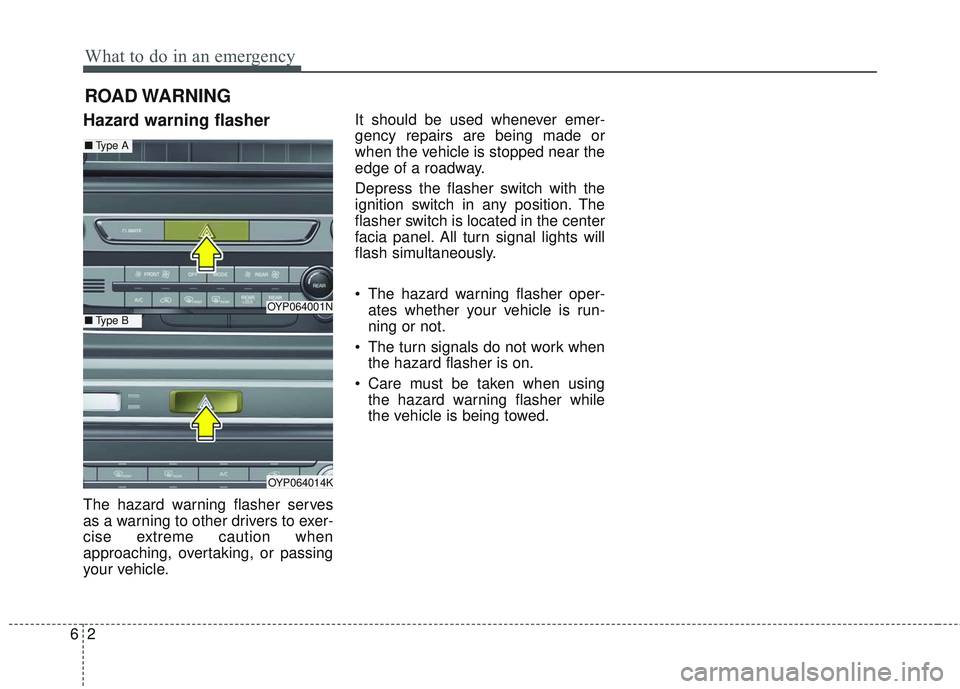
What to do in an emergency
26
ROAD WARNING
Hazard warning flasher
The hazard warning flasher serves
as a warning to other drivers to exer-
cise extreme caution when
approaching, overtaking, or passing
your vehicle.It should be used whenever emer-
gency repairs are being made or
when the vehicle is stopped near the
edge of a roadway.
Depress the flasher switch with the
ignition switch in any position. The
flasher switch is located in the center
facia panel. All turn signal lights will
flash simultaneously.
• The hazard warning flasher oper-
ates whether your vehicle is run-
ning or not.
The turn signals do not work when the hazard flasher is on.
Care must be taken when using the hazard warning flasher while
the vehicle is being towed.
OYP064001N
OYP064014K
■ Type A
■Type B
Page 477 of 586
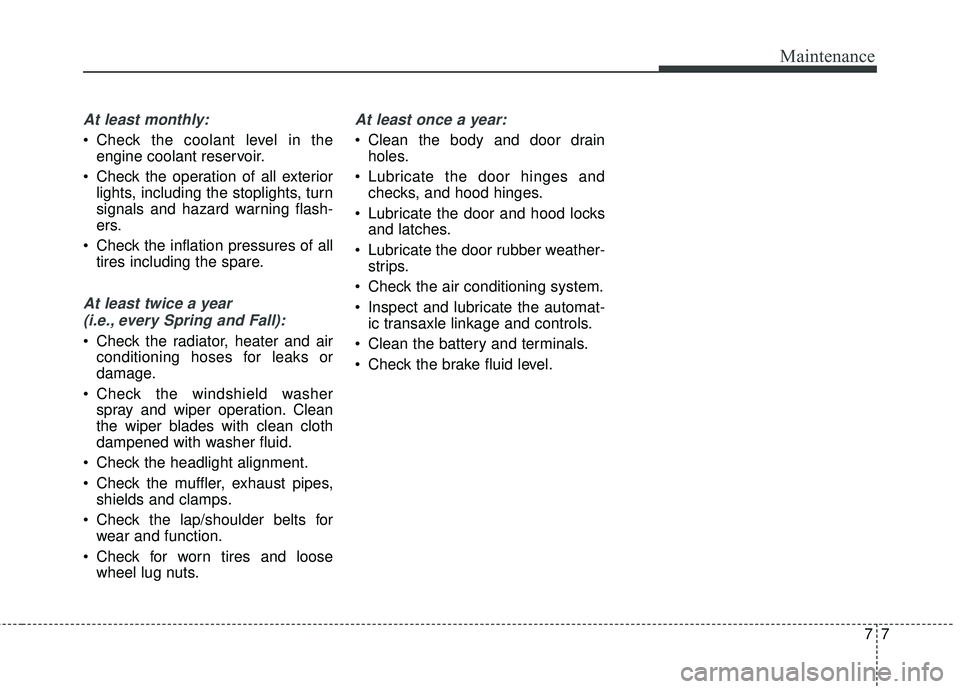
77
Maintenance
At least monthly:
Check the coolant level in theengine coolant reservoir.
Check the operation of all exterior lights, including the stoplights, turn
signals and hazard warning flash-
ers.
Check the inflation pressures of all tires including the spare.
At least twice a year
(i.e., every Spring and Fall):
Check the radiator, heater and air conditioning hoses for leaks or
damage.
Check the windshield washer spray and wiper operation. Clean
the wiper blades with clean cloth
dampened with washer fluid.
Check the headlight alignment.
Check the muffler, exhaust pipes, shields and clamps.
Check the lap/shoulder belts for wear and function.
Check for worn tires and loose wheel lug nuts.
At least once a year:
Clean the body and door drainholes.
Lubricate the door hinges and checks, and hood hinges.
Lubricate the door and hood locks and latches.
Lubricate the door rubber weather- strips.
Check the air conditioning system.
Inspect and lubricate the automat- ic transaxle linkage and controls.
Clean the battery and terminals.
Check the brake fluid level.
Page 517 of 586
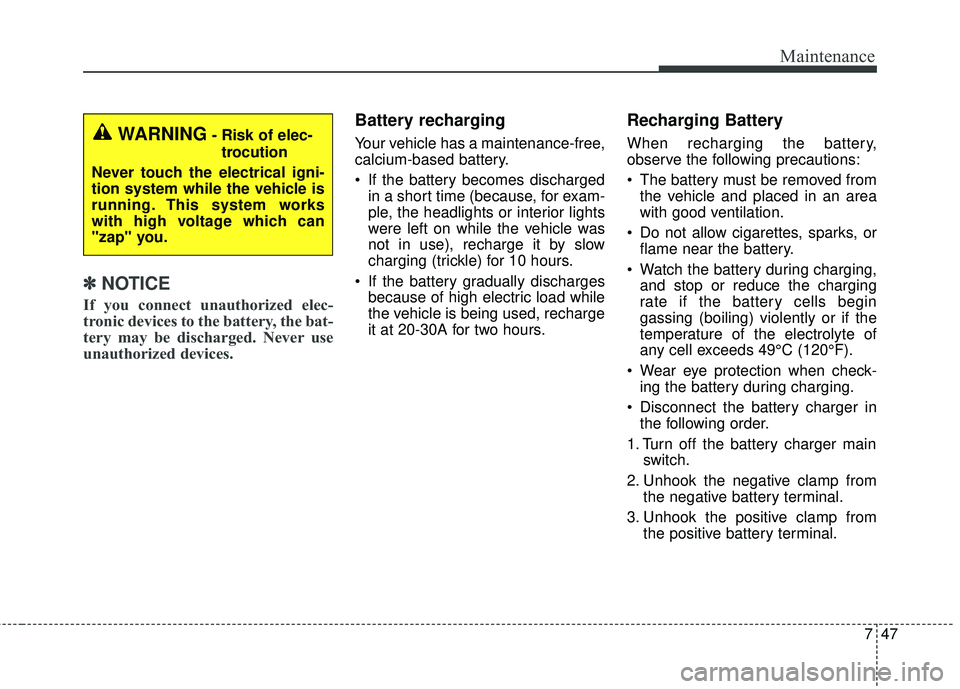
747
Maintenance
✽ ✽NOTICE
If you connect unauthorized elec-
tronic devices to the battery, the bat-
tery may be discharged. Never use
unauthorized devices.
Battery recharging
Your vehicle has a maintenance-free,
calcium-based battery.
If the battery becomes discharged
in a short time (because, for exam-
ple, the headlights or interior lights
were left on while the vehicle was
not in use), recharge it by slow
charging (trickle) for 10 hours.
If the battery gradually discharges because of high electric load while
the vehicle is being used, recharge
it at 20-30A for two hours.
Recharging Battery
When recharging the battery,
observe the following precautions:
The battery must be removed fromthe vehicle and placed in an area
with good ventilation.
Do not allow cigarettes, sparks, or flame near the battery.
Watch the battery during charging, and stop or reduce the charging
rate if the battery cells begin
gassing (boiling) violently or if the
temperature of the electrolyte of
any cell exceeds 49°C (120°F).
Wear eye protection when check- ing the battery during charging.
Disconnect the battery charger in the following order.
1. Turn off the battery charger main switch.
2. Unhook the negative clamp from the negative battery terminal.
3. Unhook the positive clamp from the positive battery terminal.WARNING- Risk of elec-
trocution
Never touch the electrical igni-
tion system while the vehicle is
running. This system works
with high voltage which can
"zap" you.
Page 534 of 586
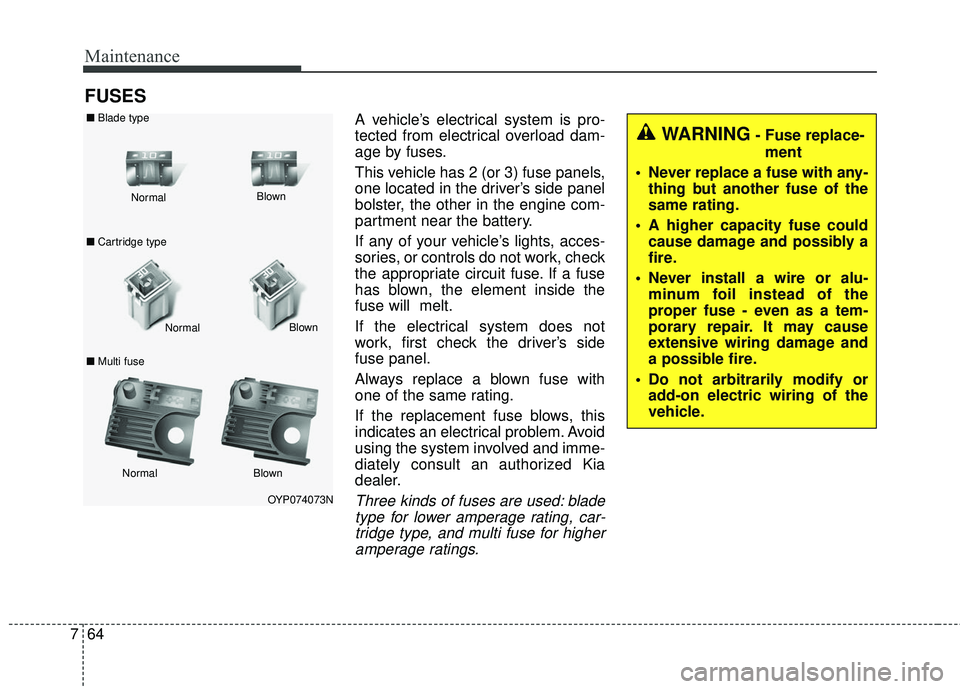
Maintenance
64
7
FUSES
A vehicle’s electrical system is pro-
tected from electrical overload dam-
age by fuses.
This vehicle has 2 (or 3) fuse panels,
one located in the driver’s side panel
bolster, the other in the engine com-
partment near the battery.
If any of your vehicle’s lights, acces-
sories, or controls do not work, check
the appropriate circuit fuse. If a fuse
has blown, the element inside the
fuse will melt.
If the electrical system does not
work, first check the driver’s side
fuse panel.
Always replace a blown fuse with
one of the same rating.
If the replacement fuse blows, this
indicates an electrical problem. Avoid
using the system involved and imme-
diately consult an authorized Kia
dealer.
Three kinds of fuses are used: blade
type for lower amperage rating, car-tridge type, and multi fuse for higheramperage ratings.OYP074073N
Normal
Normal
■
Blade type
■ Cartridge type
■ Multi fuse Blown
Blown
Normal Blown
WARNING- Fuse replace- ment
Never replace a fuse with any- thing but another fuse of the
same rating.
A higher capacity fuse could cause damage and possibly a
fire.
Never install a wire or alu- minum foil instead of the
proper fuse - even as a tem-
porary repair. It may cause
extensive wiring damage and
a possible fire.
Do not arbitrarily modify or add-on electric wiring of the
vehicle.
Page 544 of 586
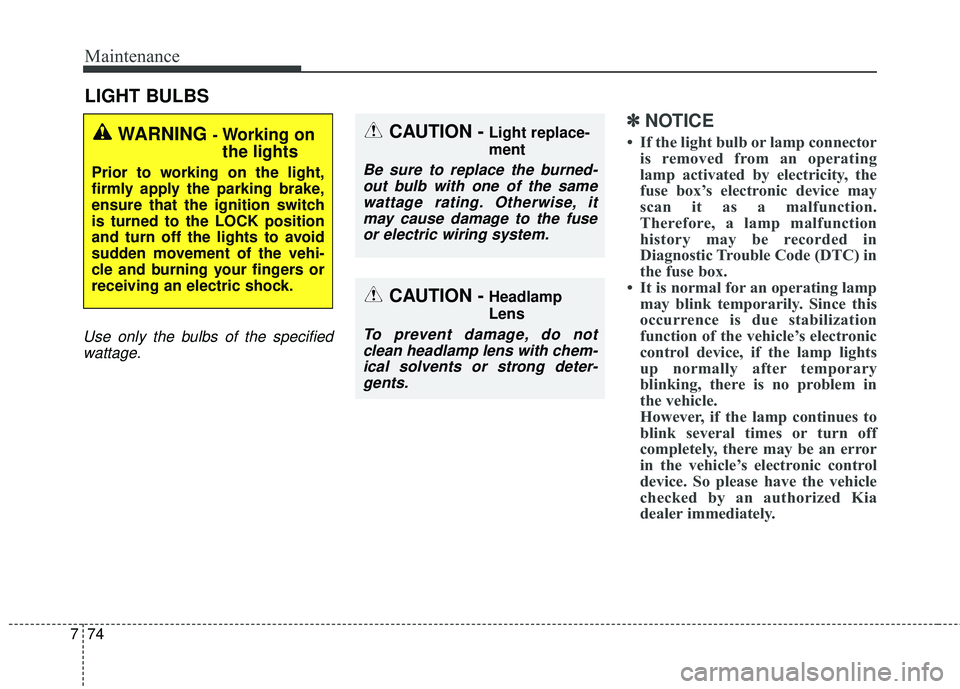
Maintenance
74
7
LIGHT BULBS
Use only the bulbs of the specified
wattage.
✽ ✽ NOTICE
• If the light bulb or lamp connector
is removed from an operating
lamp activated by electricity, the
fuse box’s electronic device may
scan it as a malfunction.
Therefore, a lamp malfunction
history may be recorded in
Diagnostic Trouble Code (DTC) in
the fuse box.
• It is normal for an operating lamp may blink temporarily. Since this
occurrence is due stabilization
function of the vehicle’s electronic
control device, if the lamp lights
up normally after temporary
blinking, there is no problem in
the vehicle.
However, if the lamp continues to
blink several times or turn off
completely, there may be an error
in the vehicle’s electronic control
device. So please have the vehicle
checked by an authorized Kia
dealer immediately. WARNING - Working on
the lights
Prior to working on the light,
firmly apply the parking brake,
ensure that the ignition switch
is turned to the LOCK position
and turn off the lights to avoid
sudden movement of the vehi-
cle and burning your fingers or
receiving an electric shock.
CAUTION -Light replace-
ment
Be sure to replace the burned-
out bulb with one of the samewattage rating. Otherwise, itmay cause damage to the fuseor electric wiring system.
CAUTION -Headlamp
Lens
To prevent damage, do notclean headlamp lens with chem-ical solvents or strong deter-gents.
Page 554 of 586
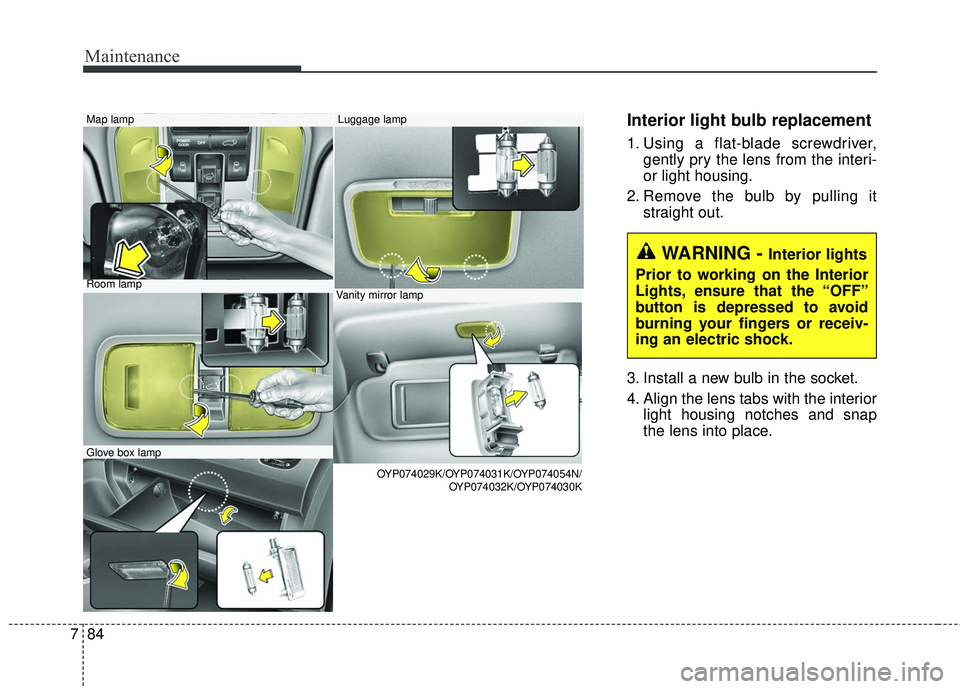
Maintenance
84
7
Interior light bulb replacement
1. Using a flat-blade screwdriver,
gently pry the lens from the interi-
or light housing.
2. Remove the bulb by pulling it straight out.
3. Install a new bulb in the socket.
4. Align the lens tabs with the interior light housing notches and snap
the lens into place.
Room lamp
Map lamp
Glove box lamp
Luggage lamp
Vanity mirror lamp
OYP074029K/OYP074031K/OYP074054N/ OYP074032K/OYP074030K
WARNING - Interior lights
Prior to working on the Interior
Lights, ensure that the “OFF”
button is depressed to avoid
burning your fingers or receiv-
ing an electric shock.
Page 586 of 586
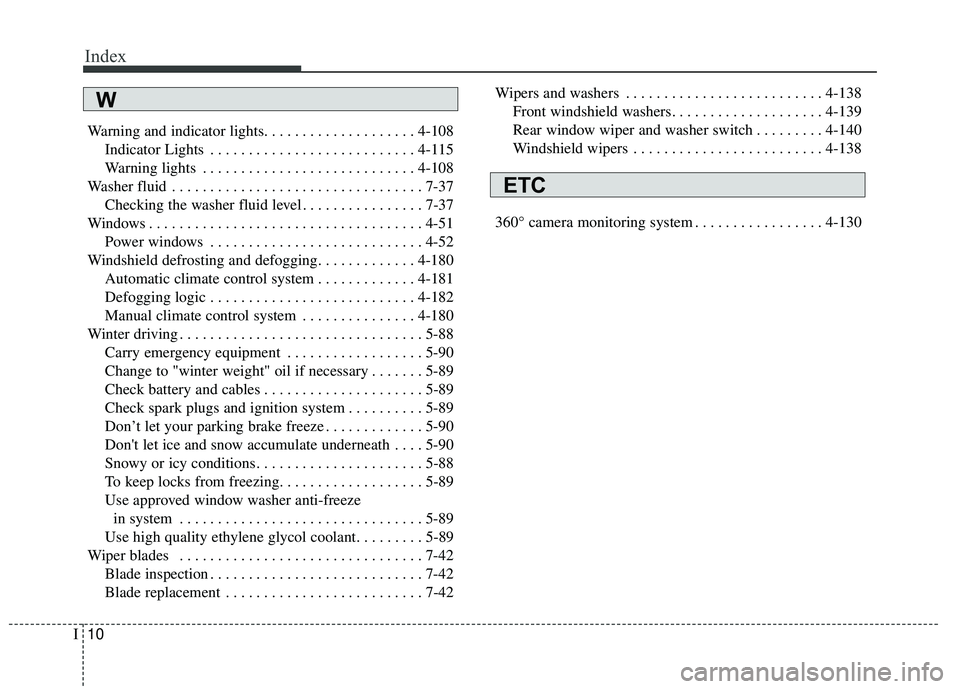
Index
10I
Warning and indicator lights. . . . . . . . . . . . . . . . . . . . 4-108Indicator Lights . . . . . . . . . . . . . . . . . . . . . . . . . . . 4-115
Warning lights . . . . . . . . . . . . . . . . . . . . . . . . . . . . 4-108
Washer fluid . . . . . . . . . . . . . . . . . . . . . . . . . . . . . . . . . 7-37 Checking the washer fluid level . . . . . . . . . . . . . . . . 7-37
Windows . . . . . . . . . . . . . . . . . . . . . . . . . . . . . . . . . . . . \
4-51 Power windows . . . . . . . . . . . . . . . . . . . . . . . . . . . . 4-52
Windshield defrosting and defogging. . . . . . . . . . . . . 4-180 Automatic climate control system . . . . . . . . . . . . . 4-181
Defogging logic . . . . . . . . . . . . . . . . . . . . . . . . . . . 4-182
Manual climate control system . . . . . . . . . . . . . . . 4-180
Winter driving . . . . . . . . . . . . . . . . . . . . . . . . . . . . . . . . 5-88 Carry emergency equipment . . . . . . . . . . . . . . . . . . 5-90
Change to "winter weight" oil if necessary . . . . . . . 5-89
Check battery and cables . . . . . . . . . . . . . . . . . . . . . 5-89
Check spark plugs and ignition system . . . . . . . . . . 5-89
Don’t let your parking brake freeze . . . . . . . . . . . . . 5-90
Don't let ice and snow accumulate underneath . . . . 5-90
Snowy or icy conditions . . . . . . . . . . . . . . . . . . . . . . 5-88
To keep locks from freezing. . . . . . . . . . . . . . . . . . . 5-89
Use approved window washer anti-freezein system . . . . . . . . . . . . . . . . . . . . . . . . . . . . . . . . 5-89
Use high quality ethylene glycol coolant. . . . . . . . . 5-89
Wiper blades . . . . . . . . . . . . . . . . . . . . . . . . . . . . . . . . 7-42 Blade inspection . . . . . . . . . . . . . . . . . . . . . . . . . . . . 7-42
Blade replacement . . . . . . . . . . . . . . . . . . . . . . . . . . 7-42 Wipers and washers . . . . . . . . . . . . . . . . . . . . . . . . . . 4-138
Front windshield washers. . . . . . . . . . . . . . . . . . . . 4-139
Rear window wiper and washer switch . . . . . . . . . 4-140
Windshield wipers . . . . . . . . . . . . . . . . . . . . . . . . . 4-138
360° camera monitoring system . . . . . . . . . . . . . . . . . 4-130
ETC
W